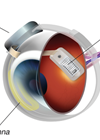Ophthalmology archive for 2016
An update on inherited retinal disorders (part 2): Approaches to therapy for IRDs
Part 1 of this topic can be found here There are currently no proven cures for inherited retinal disease (IRD). However, multiple avenues of research are being investigated to better understand disease mechanisms and trial potential therapies that may slow...
25 years of OCT
David Huang first described optical coherence tomography (OCT) in 1991, in his seminal paper on the subject in Science. This method developed the work of others on ophthalmic interferometry, which essentially showed that measuring reflected light could be used to...
Sickle cell eye disease: an overview of vitreoretinal complications and their surgical management
Sickle cell disease is the most common genetic disorder worldwide and is associated with lifelong anaemia, intermittent pain and multi-organ morbidity. Ocular involvement can be associated with significant visual impairment due to the complications of proliferative sickle retinopathy (PSR). Occasionally...
What’s new in wet AMD papers?
Paper presentations on neovascular (‘wet’) age-related macular degeneration (AMD) from the 16th European Society of Retina Specialists Congress, Copenhagen, September 2016, outline recent research directions evaluating the impact of vision loss on key health domains, patient preferences in the process...
An update on inherited retinal disorders (part 1) – overview and assessment of inherited retinal disease
Part 2 of this topic can be found here Inherited Retinal Disease (IRD) is the leading cause of blindness certification in the working age population (age 16-64 years) in England and Wales and the second most common in childhood [1]....
More sensitive visual acuity test for age-related macular degeneration
Age-related macular degeneration (AMD) is the leading cause of blindness in the developed world. Primarily associated with ageing, genetic factors and lifestyle choices such as smoking also play a contributory role. Patients with early AMD, characterised by the development of...
The bionic eye – behind the headlines
Multiple visual prosthetic projects and other vision regeneration initiatives being tested in preclinical and clinical development worldwide illustrate continuing progress and opportunities in addressing profound blindness from hereditary retinal diseases and other causes (Table 1). Three implantable bionic vision systems...
High quality retinal image grading and management service by the NetwORC UK
In 2004 a network of three ophthalmic reading centres in Belfast, London and Liverpool (known as NetwORC UK) was established to form the largest reading centre in Europe for the purpose of providing high quality grading of ophthalmic images for...
A closer look at the new wave of glaucoma surgery – radical or old school?
Glaucoma is a challenging condition to treat because the exact pathophysiology remains unclear and the only readily modifiable factor is the intraocular pressure (IOP). Additionally, most glaucoma patients are completely asymptomatic, yet are often subjected to lifelong medical therapy. The...
Optical coherence tomography – reinventing the eye examination
It has been 25 years since Huang et al. presented the first optical coherence tomography (OCT) images in Science [1]. With vast improvements in OCT technology over the years, it is now possible to acquire high-resolution cross-sectional images of the...
The David J Apple International Laboratory for Ocular Pathology – a legacy of pioneering IOL research
David Apple and Gerd Auffarth. The Apple Lab at the David J Apple Center for Vision Research in Heidelberg is a thriving international laboratory for research into intraocular devices. The lab continues the work of David J Apple, a world-renowned...
Embedding EMR for a complete transformation in user experience
Informatics and IT projects in the NHS have a history of being over budget, delivered late and not fulfilling the design brief. “But it doesn’t have to be that way,” believes Chris Canning, Consultant Ophthalmologist and Chief Clinical Information Officer...















